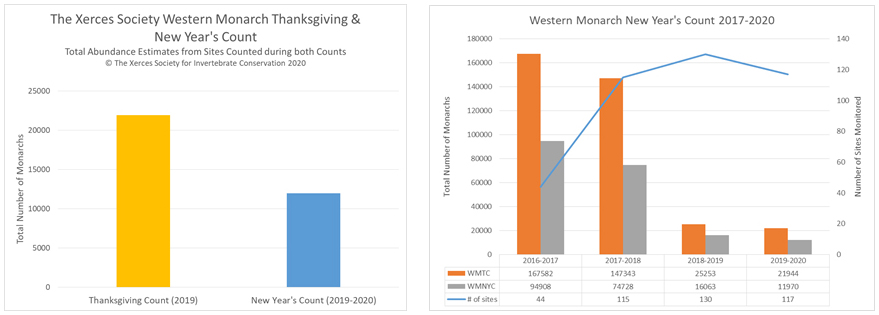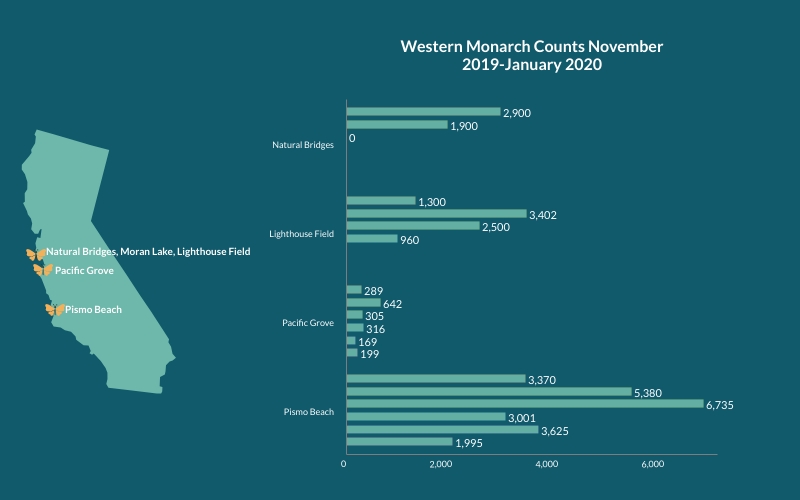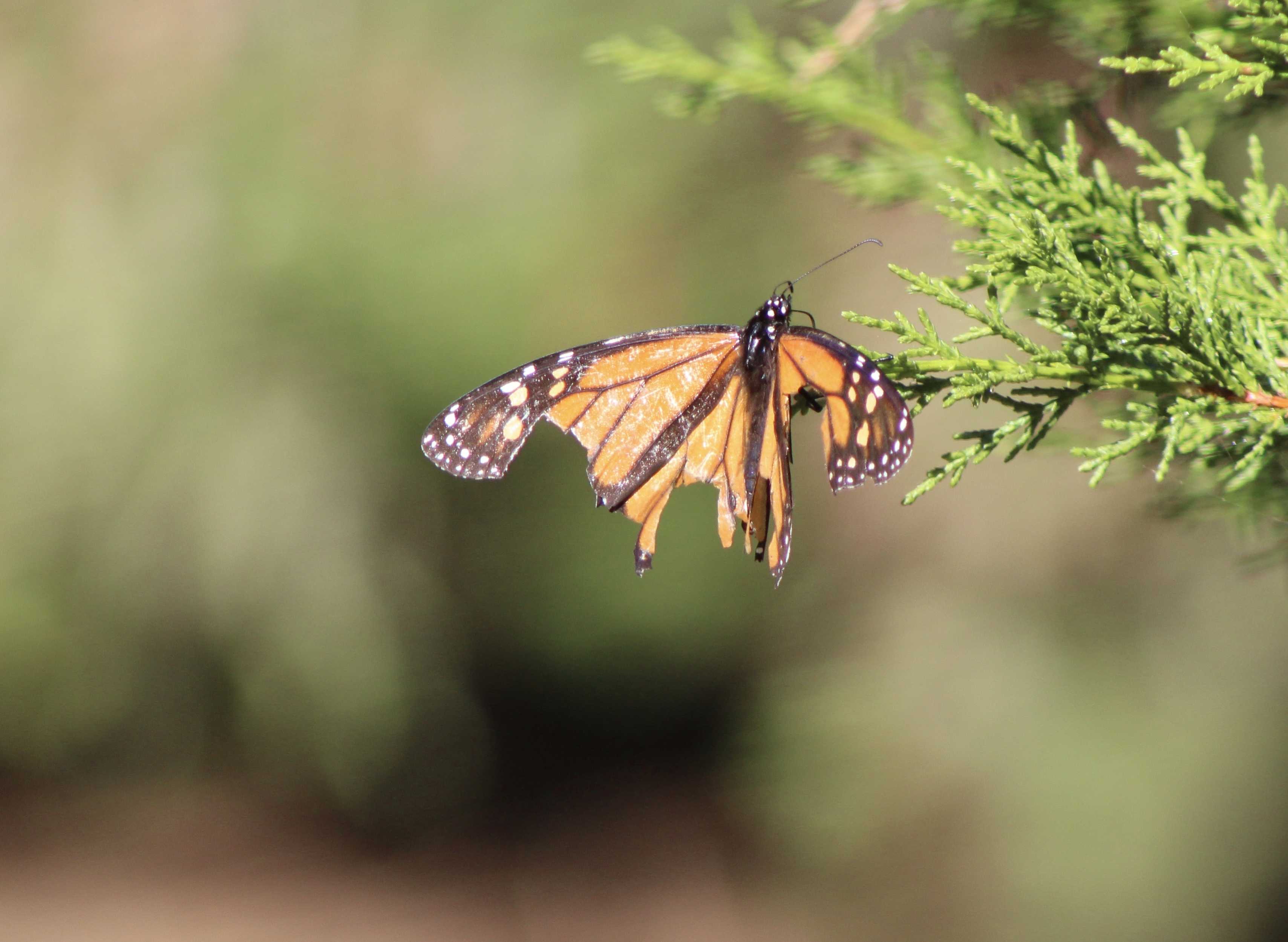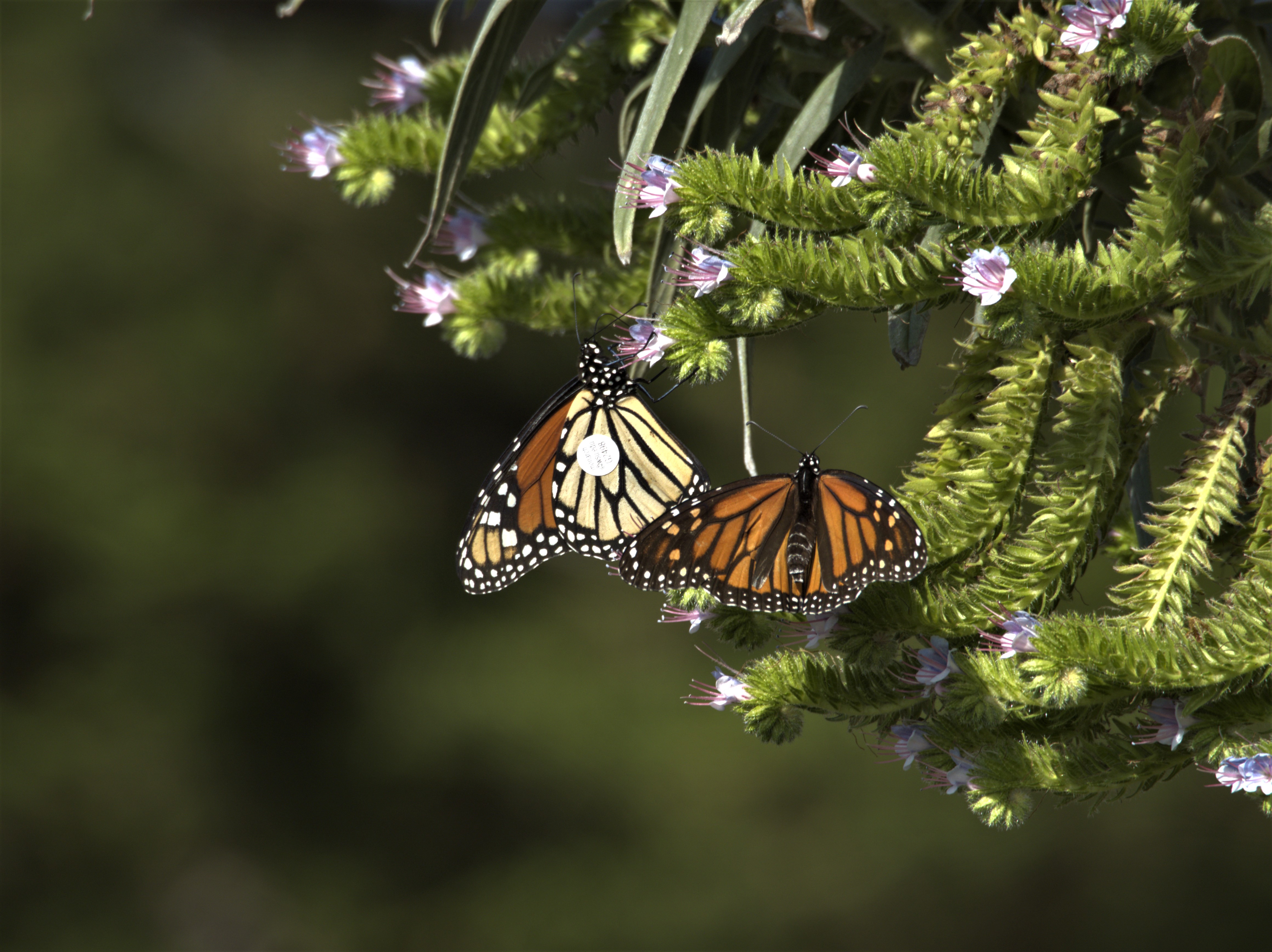Monitoring revealed an average decrease of 46% between the Thanksgiving and New Year’s counts.
This winter, many waited with bated breath for the results of the Western Monarch Thanksgiving Count (WMTC), which occurs annually around the Thanksgiving holiday. In January, after carefully tallying the results of the WMTC, we reported 29,418 monarchs at 240 overwintering sites—less than 1% of the population in the 1980s and nearly identical to last year’s alarming numbers.
Now, the Western Monarch New Year’s Count (WMNYC)—a second count that is in its fourth year—indicates that the population has fallen further. This count—which ran from Saturday, December 28, 2019 to Sunday, January 12, 2020—included 117 of the 240 sites surveyed during the WMTC.

Of the 117 overwintering sites that were monitored by volunteers during both Thanksgiving and New Year’s, 56 sites' populations declined, 25 sites' populations increased (11 of these increased from zero butterflies during the Thanksgiving count to hosting at least one butterfly during the New Year’s count), one site remained unchanged, and 35 sites hosted zero butterflies during both counts. In total, these overwintering sites witnessed a drop from 21,944 to 11,970 butterflies over the winter (Figure 1)—an average decline of 46%. This is a slightly greater decline than the 38% observed last year (winter 2018–2019), but similar to the previous two years (Figure 2). (Data is available online at westernmonarchcount.org/data.)

Among the sites monitored, Natural Bridges experienced the greatest decline between the Thanksgiving and New Year’s counts—a drop of 99%—while Lighthouse field saw the smallest decline, a reduction of 24% (Figure 3). As for some of the more well-known sites, Ellwood Mesa, Pismo Beach, Pacific Grove, and Lighthouse Field hosted more monarchs during the Thanksgiving count period, whereas Natural Bridges hosted more butterflies earlier in the overwintering season. Figure 3 illustrates how the total number of monarchs changed at each of these sites from early November through January.
So you may be wondering what this all means. First of all, let’s discuss the significance of pairing the Thanksgiving and New Year’s counts. By comparing results from the WMTC and WMNYC, we can better understand:
- How the western monarch population changes throughout the overwintering season (e.g. from mortality),
- How monarchs move between overwintering sites, and
- When monarchs are using individual overwintering sites.

This count data allows us to prioritize conservation and management of overwintering sites. For example, sites that see large drops in monarchs between the two counts may benefit from active management. The data also gives us a better picture of how many butterflies remain in California to begin the spring breeding population—which is the foundation for expansion into their summer breeding range.
While the decline that was observed this winter is alarming, the silver lining is that this data helps us better understand monarch mortality and movement over the winter. It can also help us to understand which sites are transitional (also known as autumnal sites), and which ones support monarchs throughout the winter. Now, equipped with the additional data from four years of the New Year’s Count, we have a more concrete list of priority sites to target for conservation efforts. To learn more about the need for greater protection and management of overwintering sites in California, read this recent blog post.

In addition to the New Year’s count, some dedicated volunteers have made more frequent counts throughout this year’s overwintering season (some are still ongoing) at the more well-known overwintering sites—including Ellwood Mesa in Santa Barbara County, Pismo Beach in San Luis Obispo County, Pacific Grove in Monterey County, and Lighthouse Field and Natural Bridges, both in Santa Cruz County. Based on the most recent reports, monarchs have largely left overwintering sites.
Even with this additional data from the New Year’s Count and ongoing monitoring, it is hard to pinpoint exactly why the total number of monarchs drops at overwintering sites throughout the season. We suspect that the decline is due primarily to mortality from winter storms, predation, and other causes. However, it may also be that butterflies are simply leaving overwintering sites for other areas—perhaps nectaring in gardens or natural areas—where they are not being observed, or to other overwintering sites not included in the New Year’s Count.
Where monarchs go after they leave the overwintering sites is also a relative mystery (roughly early/mid-February to early April). Because of this, researchers at Washington State University; Tufts University; University of California, Santa Cruz; and the Xerces Society have launched a campaign called the Western Monarch Mystery Challenge. This campaign runs from February 14 to April 22 this year and aims to collect records of where western monarchs spend the spring in California. Take a photo of any wild monarchs you see and report them to iNaturalist or email it to [email protected] for a chance to win prizes. All of these records will contribute to the Western Monarch Milkweed Mapper, a community science project that extends year-round, for reports of milkweed and monarchs anywhere in the western U.S.
The incredible volunteer effort during the Thanksgiving and New Year’s counts is vital in assessing the migratory monarch population in western North America. We are immensely grateful to the volunteers and regional coordinators for their time, effort, and love for monarchs.
Additional Resources
Please see our Western Monarch Call to Action for key steps to support this imperiled population. Links to a variety of monarch conservation resources are featured there, as well.
Read our press release about the latest Western Monarch Thanksgiving Count results.
Learn more about the Western Monarch Thanksgiving Count here.
Check out the Western Monarch Milkweed Mapper—a year-round community science effort.




